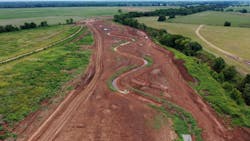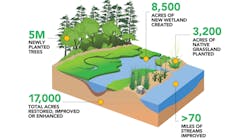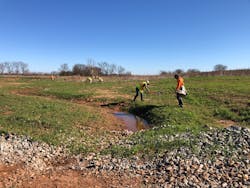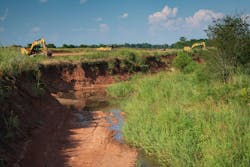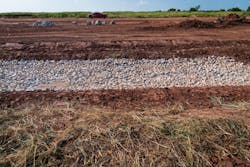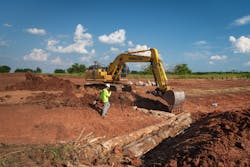RIVERBY, TX — One of largest environmental efforts in the country has just rebirthed a Texas stream. This summer, the North Texas Municipal Water District (NTMWD) orchestrated improvements to the Willow Branch Creek, which sits at the heart of 17,000 acres being restored as part of its Bois d’Arc Lake construction project. Bois d’Arc is the first major reservoir to be built in Texas in about 30 years.
NTMWD and its contractor Resource Environmental Solutions (RES) restored and enhanced approximately 17 miles of the creek and tributaries by restoring them to their natural, meandering path. This concludes a key piece of the project’s massive environmental restoration, which includes planting over 5 million trees, restoring/enhancing over 8,500 acres of wetlands, enhancing/restoring 70 miles of existing streams and planting approximately 3,200 acres of native grasslands.
“Everything comes back to water,” explains Project Manager Matt Stahman with RES. “All of the habitats we’re restoring—thousands of acres of grasslands, wetlands and woods—all of it is driven by water. If we can slow down the water across the landscape and let it soak into the ground, the better chance that the other habitats we restore [including trees and grasslands] will succeed. Previously, a lot of the streams had been straightened for drainage. One of the major things we do is restore these streams to their natural wavy, winding configuration,” Stahman explained.
The result of this massive effort? “According to everything we’ve seen so far, the results are very, very promising,” Stahman said.
The new and improved Willow Branch Creek will enhance the quality water in the Red River—benefitting the entire watershed. It will also hold rain in the local water table longer to nourish the new wetlands, trees, bushes and grassland. These benefits should continue for the foreseeable future after the plants are established. In the meantime, RES will continue to monitor the site regularly.
“We’ve really come to appreciate the people who live here and the people who lived here before,” Stahman said. “We’ve done our best to line up our project with the requests and interests of those in Fannin County.”
Steve Long, NTMWD Project Manager for the Bois d’Arc Lake project certainly agrees, “NTMWD looks forward to seeing the fruit of our hard work and collaboration—as Bois d’Arc Lake and our restorations benefit North Texans for decades to come.”
NTMWD expects to provide treated water from Bois d’Arc Lake in the Spring of 2022. Once construction work on the environmental mitigation is complete, RES will maintain, measure and monitor the results until it meets NTMWD’s permit requirements, which could take 15 years or longer.
For additional information on the whole Bois d’Arc Lake project, including its various components and construction, visit https://boisdarclake.org/.
About NTMWD
The North Texas Municipal Water District is a regional wholesale provider of water, wastewater and solid waste disposal services for approximately 1.8 million residents across 10 counties – a service territory covering 2,200 square miles.
About RES
Resource Environmental Solutions serves as the nation’s only fully scaled operating company, providing comprehensive ecological restoration and water resource solutions that build and sustain natural resiliency in local ecosystems.
